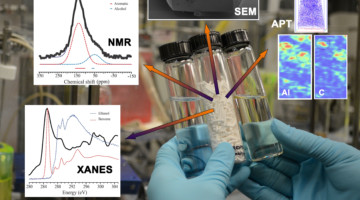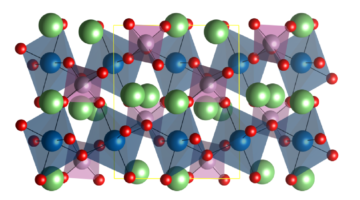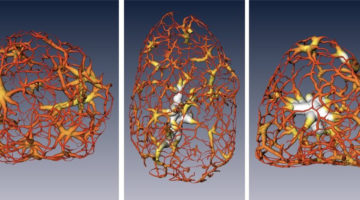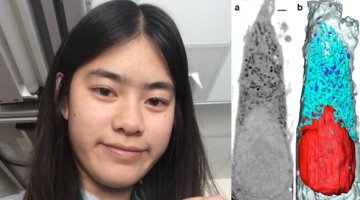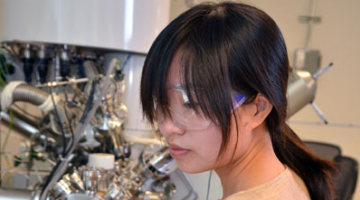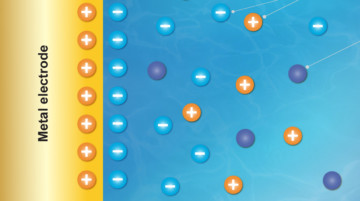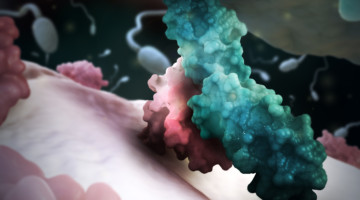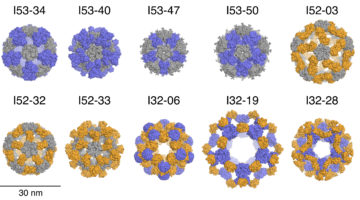A team of researchers has employed a combination of measurements, including x-ray experiments at the ALS, to gather the most detailed information yet on problematic carbon-based deposits called “coke,” and to find ways to prevent its formation or reduce its effects. Read more »
Understanding Barriers to Higher-Capacity Rechargeable Batteries
Vanadyl phosphate can theoretically accept twice the number of lithium ions as battery materials currently in use. In practice, however, it doesn’t live up to expectations. New research at Beamline 6.3.1 using a variety of hard and soft x-ray spectroscopies helps zero in on why. Read more »
3-D Imaging Technique Maps Migration of DNA-carrying Material at the Center of Cells
Scientists have mapped the reorganization of genetic material that takes place when a stem cell matures into a nerve cell. Detailed 3-D visualizations show an unexpected connectivity in the genetic material in a cell’s nucleus, and provide a new understanding of a cell’s evolving architecture. Read more »
What I Did Last Summer: Co-Authored a Scientific Paper!
Young ALS user Jessica Guo may still be in high school, but she already has a peer-reviewed journal publication to her credit, based on work done at the ALS. She is a co-author of a paper published in Biology of the Cell on mesoscale imaging with cryo-light and x-rays. Read more »
Solar Cells Get Boost with Integration of Water-Splitting Catalyst onto Semiconductor
Scientists have found a way to engineer the atomic-scale chemical properties of a water-splitting catalyst for integration with a solar cell, and the result is a big boost to the stability and efficiency of artificial photosynthesis. Read more »
Around the ALS in Photos: 2016 ALS User Meeting
This month’s photo essay goes inside the 2016 ALS User Meeting, from registration to the award ceremony and workshops. Look for people you know or find yourself in the crowd! Don’t forget to click the “Enjoy” button at the end if you did! Read more »
ALS in the News (Oct 2016)
- Transformational X-ray Project Takes a Step Forward
- Crystal Clear Imaging: Infrared Brings to Light Nanoscale Molecular Arrangement
- Energy Focus: Electric Fields Help Oxygen Slip through the Cracks for Ultralow Power Electronics
- Peering Into Batteries: X-Rays Reveal Lithium-Ion’s Mysteries
- HyMARC Designated As an Approved Program at the Advanced Light Source
- UC Berkeley, UCLA, CU Boulder Scientists Collaborate to Improve Real-Time Functional Imaging
- Peter Nico Announced as Program Domain Lead for Sustainable Energy Systems
- Scientists Find Twisting 3-D Raceway for Electrons in Nanoscale Crystal Slices
- ALS/Molecular Foundry SLAM #NPAW2016
- A Conscious Coupling of Magnetic and Electric Materials
- Scientists Find New Way to Manipulate Size of Virus-Like Particles
- Molecular Foundry Established as Its Own Division
Tender X-Rays Map the Double-Layer Potential
In a first-of-its-kind experiment, ALS researchers demonstrated a new, direct way to study the inner workings of a phenomenon in chemistry known as an “electrochemical double layer” that forms where liquids meet solids—where battery fluid meets an electrode, for example. Read more »![]()
![]()
A Molecular View of Sperm–Egg Fusion
Researchers have uncovered the first interactions between the human sperm and egg—the initial steps in the creation of human life. The discovery lays a foundation to better understand fertilization and could lead to the development of non-hormonal contraceptives. Read more »
Designed Protein Nanocages Inspired by Nature
Inspired by protein molecules observed in nature, researchers have now engineered ten large, 120-subunit, two-component protein complexes. These designed nanomaterials are attractive starting points for new approaches to targeted drug delivery, vaccine design, and bioenergy. Read more »
- « Previous Page
- 1
- …
- 65
- 66
- 67
- 68
- 69
- …
- 77
- Next Page »
